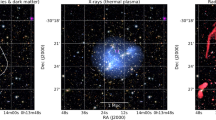Abstract
Recent high resolution near infrared (HST-NICMOS) and mm-interferometric imaging have revealed dense gas and dust accretion disks in nearby ultra-luminous galactic nuclei. In the best studied ultraluminousIR galaxy, Arp 220, the 2μm imaging shows dust disks in both of the merging galactic nuclei and mm-CO line imaging indicates molecular gasmasses ∼ 109M⊙ for each disk. The two gas disks in Arp 220 are counterrotating and their dynamical masses are ∼ 2×109 M ⊙, that is, only slightly largerthan the gas masses. These disks have radii ∼100 pc and thickness 10-50 pc. The high brightness temperatures of the CO lines indicatethat the gas in the disks has area filling factors ∼25-50% and mean densitiesof ≥ 104 cm-3. Within these nuclear disks, the rate of massive star formation is undoubtedly prodigious and, given the high viscosity of the gas, there will also be high radial accretion rates, perhaps ≥ 10 M⊙ yr -1. If this inflow persists to very small radii, it is enough to feed even the highest luminosity AGNs.
Similar content being viewed by others
References
Baan, W.A. and Haschick, A.D. (1995),Astrophys. J., 454, 745.
Baan, W. A., van Gorkom, J.H., Schmelz, J.T. & Mirabel, I.F. (1987), Astrophys. J., 313, 102.
Barnes, J.E., and Hernquist, L.E., (1991) Astrophys. J., 370, L65.
Downes, D. and Solomon, P.M., (1998) Astrophys. J., in press.
Graham, J.R., Carico, D.P., Matthews, K., Neugebauer, G., Soifer, B.T., & Wilson, T.D. (1990), Astrophys. J., 354, L5
Joseph, R.D. & Wright, G.S. (1985),MNRAS, 214, 87.
Larkin, J.E., Armus, L., Knop, R.A., Matthews, K., & Soifer, B.T. (1995), Astrophys. J., 452, 599.
Norman, C.A. and Scoville, N.Z. (1988), Astrophys. J.,332, 124.
Norris, R.P., (1985) MNRAS, 216, 701.
Sakamoto, K., Scoville, N., Yun, M.S., Crosas, M., Genzel, R. and Tacconi, L. (1998),Astrophys. J., in press.
Scoville, N.Z., et al (1998),Astrophys. J., 492, L107.
Scoville, N.Z., Yun, M.S., and Bryant, P.M. (1997), Astrophys. J., 484, 702.
Soifer, B.T., et al (1987), Astrophys. J., 320, 238.
Tacconi, L., et al (1998), Astrophys. J., in press.
Author information
Authors and Affiliations
Rights and permissions
About this article
Cite this article
Scoville, N. Massive accretion disks. Astrophysics and Space Science 266, 149–155 (1999). https://doi.org/10.1023/A:1002662001277
Issue Date:
DOI: https://doi.org/10.1023/A:1002662001277




